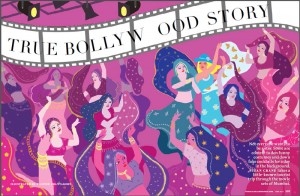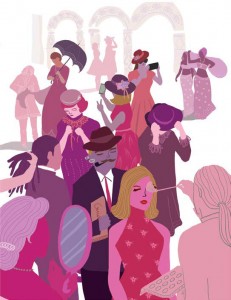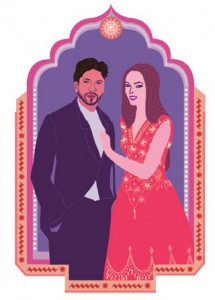 I came to Mumbai to be discovered. Well, sort of. I actually came to India’s most populous city to secure my fifteen seconds of fame as an extra in one of the approximately 1,000 Bollywood extravaganzas—twice Hollywood’s output—that are churned out each year by the prolific fantasy factory. In this three-plus-billiondollar annual industry, Hindi filmmakers regularly seek foreign faces to provide international human wallpaper for scenes ostensibly shot in the likes of London, Dubai or Sydney. And I wanted to be among them. By bizarre happenstance, I’d had a brief flirtation with the fame monster several days earlier in, of all places, Kathmandu when, returning to Thamel district from a hair appointment, I walked smack into the filming of a music video by Nepali actor/comedian Hari Bansha Acharya. Next thing I knew, I was on set alongside four other pale foreigners dancing to a folk-inspired pop concoction lacing the sweet strings of a traditional sarangi with the djimbe’s percussive groove. It was catching. And left me keener than ever to clock additional screen time across the border in India, impending 14-hour workdays for a measly 500-rupee “fee” be damned.
I came to Mumbai to be discovered. Well, sort of. I actually came to India’s most populous city to secure my fifteen seconds of fame as an extra in one of the approximately 1,000 Bollywood extravaganzas—twice Hollywood’s output—that are churned out each year by the prolific fantasy factory. In this three-plus-billiondollar annual industry, Hindi filmmakers regularly seek foreign faces to provide international human wallpaper for scenes ostensibly shot in the likes of London, Dubai or Sydney. And I wanted to be among them. By bizarre happenstance, I’d had a brief flirtation with the fame monster several days earlier in, of all places, Kathmandu when, returning to Thamel district from a hair appointment, I walked smack into the filming of a music video by Nepali actor/comedian Hari Bansha Acharya. Next thing I knew, I was on set alongside four other pale foreigners dancing to a folk-inspired pop concoction lacing the sweet strings of a traditional sarangi with the djimbe’s percussive groove. It was catching. And left me keener than ever to clock additional screen time across the border in India, impending 14-hour workdays for a measly 500-rupee “fee” be damned.
I headed out my first Mumbai morning in the tourist enclave of Colaba—a favored haunt for recruiters—in the hopes of being noticed. Up and down the road behind the iconic Taj Mahal Palace Hotel I pranced. In front of the lowbrow Salvation Army Red Shield Guest House I preened. Through the Causeway and around India Gate I strutted. To no avail. Only touts trumpeting “good cheap room” paid me any heed. Clearly streetwalking was not to be my ticket through Bollywood’s rarified gates.
So, I reached out to veteran “foreign models” guru Imran Giles, a fast-talking used-carsalesman sort who herds human scenery into many of Bollywood’s biggest films. “I must get on set,” I implored the hotshot agent. “What’s in it for me?” he queried opportunistically. “Your fifteen seconds of fame in my story?” I offered. “Well, I actually need a favor,” he countered in a machine-gun staccato. He needed 25 Westerners under 30, and he needed them in the next four hours for a shoot later that day on Happy New Year. While I was “age inappropriate” for the blinged-out song-and-dance spectacle directed by Farah Khan and starring “King of Bollywood” Shahrukh Kahn, I was assured my moment of celluloid glory later in Bombay Velvet, a high-profile period opus featuring heartthrob Ranbir Kapoor, scion of an acting dynasty. But first, I had to deliver Giles’s quota.
And so it happened that I became a Bollywood scout combing the streets for tourists who prized fleeting infamy, and perhaps a different insight into modern India, above monetary compensation. They were to receive about 500 rupees per day; I, 100 rupees per fair-haired head. Piece of cake assignment, I assumed. After all, I’m a friendly Western female slinging a benign pitch that usually began with “Excuse me, this might sound strange…” But I had more roles on offer than there were “suitable” foreigners wandering about, and guidebook warnings about shifty pavement pounders severely hindered my efforts. Eventually, however, I was able to corral 15 multinational travelers and off we went to Film City, center of the Bollywood universe. Through a heavily guarded entrance we encountered a second layer of security before reaching the inner sanctum, otherwise known as the soundstage. Cameras and phones were confiscated, the veil of secrecy enshrouding these costly colossal productions thick as a thundercloud.
 Since I wasn’t to be “acting” in this film—being “age inappropriate” and all—I killed time by learning a few Persian dance moves from a group of Iranian and Afghani extras culled from Pune’s Middle Eastern student population, and practicing my Spanish with a Minorcan couple I’d drafted earlier near Colaba’s renowned Leopold Café. I also gleaned some hot gossip and spicy Bollywood trivia, including the little-known fact that on-screen kisses were more passionately rendered prior to 1954, when India’s Prime Minister Jawaharlal Nehru addressed complaints about the “corrupting influence” of “precocious sex habits” displayed in films. As for the heat quotient that may or may not ignite Happy New Year, I’ve no idea, as the bit I observed focused on a high-octane dance contest rather than any scripted relationship between Shahruhk Kahn and his comely co-star Deepika Padukone. I’ll get back to you on the sizzle factor upon the film’s Diwali (October 23) release.
Since I wasn’t to be “acting” in this film—being “age inappropriate” and all—I killed time by learning a few Persian dance moves from a group of Iranian and Afghani extras culled from Pune’s Middle Eastern student population, and practicing my Spanish with a Minorcan couple I’d drafted earlier near Colaba’s renowned Leopold Café. I also gleaned some hot gossip and spicy Bollywood trivia, including the little-known fact that on-screen kisses were more passionately rendered prior to 1954, when India’s Prime Minister Jawaharlal Nehru addressed complaints about the “corrupting influence” of “precocious sex habits” displayed in films. As for the heat quotient that may or may not ignite Happy New Year, I’ve no idea, as the bit I observed focused on a high-octane dance contest rather than any scripted relationship between Shahruhk Kahn and his comely co-star Deepika Padukone. I’ll get back to you on the sizzle factor upon the film’s Diwali (October 23) release.
As day turned into night and back into day again, enthusiasm among the juniors—as Bollywood refers to extras, who in this case were festooned in flamboyant getups that evoked a Michael Jackson video circa 1985—began to wane. Frustration and a few complaints filtered through the hazy studio, even among those earning 1,000 rupees daily and free accommodation in exchange for longer term commitments to the project. Lizzie, a young British backpacker in garish green sequins, was more sanguine. “I’m making some cash and the hotel is better than the hostel in which I’d been staying,” she shrugged during her interminable, chai-fueled wait to be called on set. Still, despite the obvious tedium, I was eager to get my chance to be on camera. Two days later, it finally arrived.
Six-thirty a.m. on the deserted street in front of Starbucks. But for a few early risers and vagrants, the music of this chaotic city has yet to kick off. Slowly, a handful of foreigners ambles toward the meeting point, all bleary eyed and undoubtedly questioning their sanity. A Chinese couple emerges from the shadows followed by a German Rasta dude. A Latvian choreographer is accompanied by her father, a French professional dancer and her Egyptian boyfriend loping close behind. Some lug rucksacks as they’ll be dropped at the train station after filming. We’re marshaled onto a minibus bound for the venerable Mahalaxmi Race Course about 20 minutes away to participate in the neo-noir epic Bombay Velvet. Inspired by James Ellroy’s L.A. Quartet crime novels and based on the book Mumbai Fables by Indian historian Gyan Prakash, the story explores the birth of this metropolis, its dark underside brewing in a cauldron of love, greed, violence and jazz music.
 On location we meet another band of foreign extras and hordes of Indian nationals, many of whom are professional juniors. Some are bored housewives, I’m told by a retired Air India flight attendant who does extra work once or twice a week to stave off inertia. All of us are quickly ushered into the frenzied wardrobe, hair and makeup area. Men are shuttled off in one direction, the women in another. Boxes upon boxes of clothing and accessories are helmed by hapless stylists tasked with matching garment to body type. “Too big.” “Too small.” “Needs to cover tattoo.” Needs to cover any number of other unseemly affectations. Even for extras, perfection is the goal.
On location we meet another band of foreign extras and hordes of Indian nationals, many of whom are professional juniors. Some are bored housewives, I’m told by a retired Air India flight attendant who does extra work once or twice a week to stave off inertia. All of us are quickly ushered into the frenzied wardrobe, hair and makeup area. Men are shuttled off in one direction, the women in another. Boxes upon boxes of clothing and accessories are helmed by hapless stylists tasked with matching garment to body type. “Too big.” “Too small.” “Needs to cover tattoo.” Needs to cover any number of other unseemly affectations. Even for extras, perfection is the goal.
Everyone is jostling for the best costume and more attention from the stylists, the aesthetic requirements of us ingénues eclipsed by the demands of the more experienced (read: aggressive) regulars. The scene supposedly takes place in 1969 but the garb inexplicably spans a much broader swath of time. Donning a high-collared flowery frock, lace gloves and feather-embellished bonnet, I resemble a frilly 1940’s housewife, while a statuesque blonde beside me is bedecked in a brocade gown from an earlier era. The guys variously emerge in Al Capone three-piece suits and skinny 1960’s ties, some sporting mock mustaches and others with precariously placed fedoras obscuring wild dreadlocks. Hours pass and more bit players begin to appear, clad in a confusing array of saris and Western-wear replete with parasols, fans, Jackie O sunglasses and Queen Elizabeth hats.
Unlike the shadowy Vegas ambiance of the Happy New Year indoor shoot, we’re blessed with vibrant sunshine and a welcome breeze, Mumbai unfolding like a panoramic postcard from the sprawling grounds of the famed racetrack. After a quick breakfast, we’re steered into the bleachers, hundreds of us, a veritable United Nations of background players. I am thrilled. Faux cocktails are dispensed, while a production assistant seeks smokers for authenticity. “Don’t light up until we roll film” she commands—though some of us, tired of waiting, ignore the edict. More cigarettes and cigars are distributed for the actual take. “This is cool,” Frederico from Argentina, opines. “We get to smoke and fake drink, all in the name of cinema verité.” Yes, this is fun, I agree. As we sit in the truly grand spectator stands, a designated heritage site that dates back to 1883, the overall impression is of a stylistic collision between The Great Gatsby and the polo scene in Pretty Woman. But it’s easy to dismiss the anachronisms; I’m in a Bollywood film. And not just any Bollywood film—one of the year’s most eagerly anticipated and pricey, with budget estimates ranging between a staggering 92 and 117 crores (one crore is 10,000,000 rupees).
The cameras are positioned and soon a hush befalls the crowd. In our midst, the three leads have congregated, ready for action. Rambir Kapoor, Anushka Sharma and Karan Johar are all young Bollywood A-listers and, framed by a coterie of groomers, they look like it. In short order, several crew members trot onto the field, pretending to be the horses that will later replace them on film. Through multiple takes, the extras are instructed to cheer, clap and otherwise exhibit emotions befitting a day at the races. Frederico becomes my foil as we both animatedly immerse ourselves in character. Way in the back rows, Indian extras are texting on their smart phones, well aware that they’re not in range of the cameras, which periodically shift to invoke a larger crowd than actually exists. Occasionally, a cinematographer seems to be aiming towards my section, my row even, and my hopes soar that I’ll make it uncut through editing.
After lunch, several of us are assigned more prominent positions, although I’m pretty sure they are shooting from behind. As the day draws on and the sun smolders above, our initial fervor gives way to lethargy. The ovations became weaker, the gesticulations less spirited. And then, some twelve hours after our arrival, the director calls cut for the final time. The scene captured and our jobs complete, the rush to disrobe and return our props is frantic, harried stylists fielding flying accessories like a baseball catcher. In the bus back to Colaba, the weary extras are generally happy with the experience, happier still that it’s over. A few offer to return the next day, but most are content with their furtively obtained behind-the-scenes snapshots, 15 seconds of fame, and enduring tales of their Bollywood debut.
A Bollywood set is sort of a microcosm of India itself, where life blazes in vivid paradoxical Technicolor. At once maddening and inspiring, swift-paced and slow, absurd and profound, mystifying and mystical. This is why I’m hitting the streets again tomorrow to assemble another troop of unsuspecting recruits for the next Happy New Year night shoot. Sure, there’s a price on each head. But I fancy myself more Santa Claus than bounty hunter: I truly do want to give others this experiential gift. And, perhaps more importantly, I just never know what adventure awaits me around the next corner. India is just like that. Excuse me, this may sound strange…
Stay
Abode Boutique Hotel In a refurbished Colaba heritage building, this intimate 20-room bed and breakfast has recycled furnishings, rain showers and amenities such as eye masks and complimentary mobile phones in deluxe rooms. 1F, Lansdowne House, M.B. Marg, Apollo Bunder, Colaba; 91-80/ 8023-4066; abodeboutique hotels.com; doubles from Rs3,500.
Palladium Hotel This favored hangout of the city’s jetset provides 335 rooms, 28 suites, a lavish spa, panoramic swimming pool, two award-winning restaurants (plus another four soon-to-launch eateries), a designer mall and three nightlife venues. 462, Senapati Bapat Marg, Lower Parel; 91-22/6162- 8000; palladiumhotel.in; doubles from Rs10,500.
Taj Mahal Palace Mumbai’s historic, enormous, bay-view grand dame has over the years hosted dignitaries and luminaries from Barack Obama and Prince Charles to George Bernard Shaw and the Beatles. Apollo Bunder; 91-22/6665-3366; tajhotels.com; doubles from Rs13,250.
EAT +DRINK
Where to spot celebrities over dinner or drinks:
Aurus A lauded chef who excels at elegantly eclectic dishes, a whimsical drinks menu and a glam open-air seafront setting make this a hotspot among Juhu’s celebs. 12, Nichani Kutir, Juhu Tara Rd., Juhu; 91-22/6710-6666; dinner for two Rs5,000.
China House Some of the best traditional pan- Chinese in town comes out of this resto-lounge’s interactive glass kitchen. Grand Hyatt Hotel, off Western Express Hwy., Santacruz East; 91-22/ 6676-1149; hyatt.com; set menu for two Rs5,000.
EXO Mumbai’s current it spot, this raging bi-level club pulses to the beats of renowned DJs and draws a hip and elite nocturnal crowd. 37F, Palladium; 91-22/6162-8422; drinks for two Rs1,600.
Hakkasan Encased by back-lit blue glass with dark-stained English oak screens, this acclaimed eatery in trendy Bandra is pure drama. Kristal, 206 Waterfield Rd., Bandra West; 91-22/2644- 4444; hakkasan.com; dinner for two Rs3,000.
Li Bai Boasting amazing views, this urbane lounge offers live music on weekends, a chance to hobnob with the glitterati and an impressive selection of cigars and libations. 37F, Palladium; 91-22/6162-8422; drinks for two Rs1,600.
Mekong Offering a culinary journey through the far reaches of Asia, this award-winning eatery also has enviable city views. 37F, Palladium; 91-22/6162-8422; dinner for two Rs4,000.
Olive Bar & Kitchen A candlelit indoor/outdoor ambiance offsets a lauded Mediterranean menu. Chill Sunday brunch; Thursday Bar Night is Bollywood’s midweek groove. Pali Hill Tourist Hotel, 14 Union Park, Khar West; olivebar andkitchen.com; 91-22/ 3348-7724; dinner for two Rs2,500.
Trilogy This sexy ocean-view nightclub is a long-time mainstay of the Mumbai party circuit. Hotel Sea Princess, Juhu Tara Rd., Santracruz West; 91-22/2646-9689; trilogy. in; drinks for two Rs1,600.
DO
Get cast in a movie Agent Imran Giles, owner of Casting Stars, is often on the hunt for foreign faces—or even a bit of help scouting them. 91-98/1994-6742; imran@ gmail.com.
Originally published in Travel And Leisure SouthEast Asia, June 2014. DOWNLOAD




 Global Gypsy Collection ©2010 - 2011
Global Gypsy Collection ©2010 - 2011